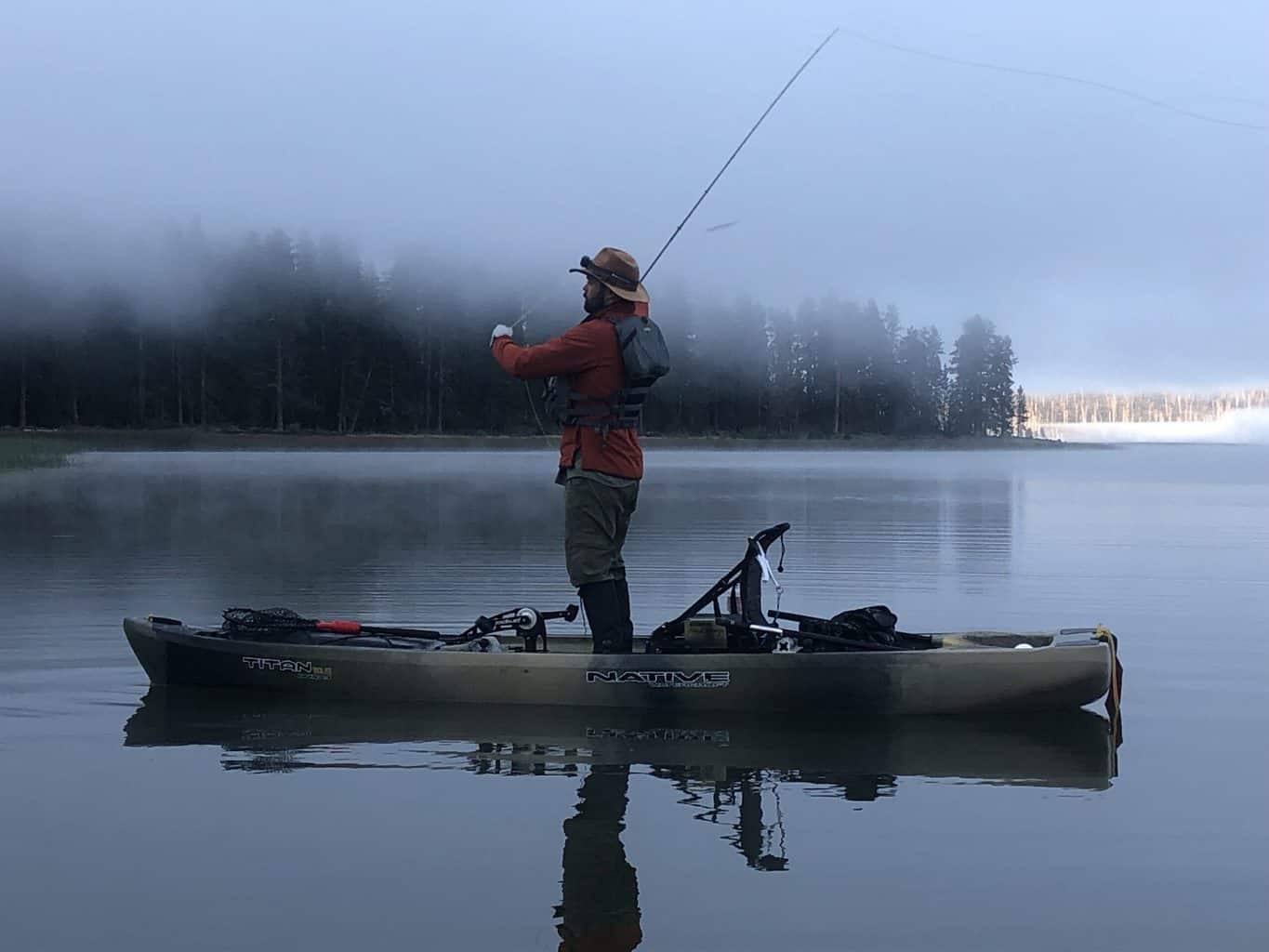Also see:
Davis Lake Rainbow Trout Fishing
Davis Lake is one of the major fishing destinations along the cluster of Central Oregon’s Cascade lakes along Century Drive southwest of Bend.
Long-known among fly anglers as a hot spot for really large native rainbow trout, someone illegally introduced largemouth bass into the shallow, weedy lake.
The new fishery took off in the 1990s and now can be a bigger draw than the trout angling at Davis, and longtime guide Fred Foisset personally takes clients there a couple dozen times in the season.
“The fact is, (bass) don’t belong there but they ARE there. I will fish for anything that eats a fly,” he said. “People who do it, they just have a blast.”
Foisset’s customers have landed bass up to 8 pounds, but now that the fishery is more popular (and the Oregon Department of Fish and Wildlife has relocated some Davis bass to other waters), the more typical bass run in the 3- to 4-pound class.
Fishing Regulations
Davis Lake is restricted to fly fishing techniques, and all flies must be barbless. Check ODFW’s Sport Fishing Regulations for the legal definition of fly fishing.
The lake is open year-round below the boat ramp at West David Lake Campground, which is in the Odell Creek channel. Anglers may fish one hour before sunrise until one hour after sunset.
There is no limit on the size and number of bass harvested at Davis in an effort to help maintain the catch-and-release trout fishery, but many anglers also release bass.
Best Fishing Times
Davis Lake is held by a natural lava dam that is prone to leak, sometimes creating a vortex visible swirling on top of the water.
In some years, the water of the already shallow lake can get very low and too warm, and the fishing falls off until the cold weather kills the bite for the season.
The bass fishing is usually worth the trip in the spring, as soon as the snow melts enough to get to Davis, which often occurs by late April to early May in typical years.
In low snowfall years, it is sometimes possible to catch bass as early as March.
The most reliable season for bass starts around mid-May and continues throughout June.
The fish typically go on the spawning beds when the water hits about 64 degrees, but when that happens varies tremendously by the year.
The best fishing is in the pre-spawn period, when the fish are extremely aggressive and tend to school up.
They also will strike while guarding nests, but not as reliably, and some fly anglers choose to lay off during the spawn.
The bite resumes full force about a week after bass leave their nests.
Fishing success during the warm summer season will depend greatly on water conditions. Consult a local source before heading up to Davis after July 1.
Where to Catch
The first parts of the lake to warm up, producing early bass bites, are the eastern shore and along the black lava rocks of the natural dam toward the north end of the lake.
As the lake warms, just about any visible structure will hold fish. Early in the year, mats of dead tules and rocks provide some of the best bass cover.
Later, growing tules and lily pads offer excellent cover all around the shoreline.
Best Flies for Davis Lake Bass
Davis Lake bass will attack large streamers – 2 ½ to 3 inches tied on hooks ranging in size from 4 up to 3/0 – that look like baitfish such as chubs, sculpin and whitefish, which are all forage species found in the lake.
Woolly Buggers, leeches and similar large sinking patterns also are very effective at Davis.
When the water warms, the bass readily attack surface patterns. At that time of year, Foisset typically employs poppers with foam heads.
During lighter periods of the day, he employs quieter patterns and techniques, but at first and last light the noisier approaches seem to draw vicious strikes.
Using fly patterns with a weed guard on the hook is a real advantage at Davis. Fish hooked alongside the weeds often bull their way into cover, and anglers also can fish flies equipped with guards right in the vegetation.
Use a sturdy rod to battle big bass out of cover. A 7- or 8-weight rod is ideal.
Also, use heavier leaders for bass, partly fishing around so much plant material and lava rock. A 10-pound leader is a minimum requirement, with leaders up to 20-pound test advisable.
If All Else Fails
Everyone knows bass like a good rubber worm, but molded plastics are illegal at Davis. So, Foisset and his staff tie a worm-shaped fly made of rabbit fur, with a cone head, that slays them just about every time.
“Rabbit (fur) moves in the water better than any kind of plastic will ever move,” he said.
Fred Foisset contributed to this article. He has guided anglers on Central Oregon’s lakes and streams since 1990, and he also guides outside Central Oregon during the high country’s off-season. He owns Cascade Guides and Outfitters and The Hook Fly Shop in Sunriver.
See our overview article about Davis Lake fishing here.
More: Oregon Bass and Warmwater Fishing
Oregon Resources
ODFW Weekly Fishing Report
ODFW Trout Stocking Schedule
Oregon Fishing Regulations
National Weather Service

